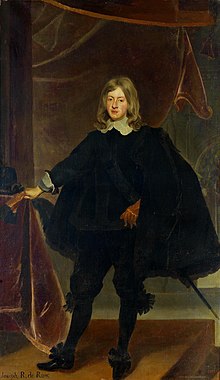Ferdinand IV (8 September 1633 – 9 July 1654) was made and crowned King of Bohemia in 1646, King of Hungary and Croatia in 1647, and King of the Romans on 31 May 1653. He also served as Duke of Cieszyn.
| Ferdinand IV | |
|---|---|
 Portrait by Frans Luycx, c. 1647-68 | |
| King of the Romans | |
| Reign | 31 May 1653 - 9 July 1654 |
| Predecessor | Ferdinand III |
| Successor | Ferdinand III |
| Co-ruler | Ferdinand III |
| King of Hungary and Croatia | |
| Reign | 16 June 1647 - 9 July 1654 |
| Predecessor | Ferdinand III |
| Successor | Ferdinand III |
| Co-ruler | Ferdinand III |
| Born | 8 September 1633 Vienna, Archduchy of Austria, Holy Roman Empire |
| Died | 9 July 1654 (aged 20) Vienna, Archduchy of Austria, Holy Roman Empire |
| House | Habsburg |
| Father | Ferdinand III, Holy Roman Emperor |
| Mother | Maria Anna of Spain |
| Religion | Roman Catholicism |
Early life
editBorn in Vienna on 8 September 1633, and baptised as Ferdinand Franz, Ferdinand IV was the eldest son of Ferdinand III, Holy Roman Emperor and his first wife Maria Anna, the daughter of Philip III of Spain.[1]
Biography
editAt a young age, Ferdinand IV took his father's place as Archduke of Austria.[2] In 1646, Ferdinand IV became King of Bohemia, sharing the role and that of Duke of Cieszyn with his father Emperor Ferdinand III. He was crowned on 5 August 1646.[3][4] Ferdinand IV also shared the role of King of Hungary and Croatia with his father; his coronation took place on 16 June 1647 in Pressburg, present-day Slovakia.[1][3]
After the French attempted to modify the system of the election of King of the Romans, Emperor Ferdinand III took advantage of a recent decline in the prestige of France, and was able to install Ferdinand IV as King of the Romans, and de facto heir to the Holy Roman Empire in the 1653 imperial election. He was crowned in Ratisbon (Regensburg, present-day south-east Germany) on 18 June 1653 after gaining the position on 31 May 1653.[5] However, Ferdinand IV unexpectedly died of smallpox in Vienna on 9 July 1654.[1] Prior to his death, it was planned that he would marry Philip IV of Spain's daughter Maria Theresa of Spain, his cousin.[2] Upon the death of Ferdinand III, Leopold was elected as Holy Roman Emperor.[5]
Ancestors
edit| Ancestors of Ferdinand IV, King of the Romans | |||||||||||||||||||||||||||||||||||||||||||||||||||||||||||||||||||||||||||||||||||||||||||||||||||||||||||||||||||||||||||||||||||||||||||||||||||||||||||||||||||||||||||||||||||||||||||||||||||||||||||||||||||||||||||||||||||||||||||||||||||||||||||||||||||||||||||||||||||||||||
|---|---|---|---|---|---|---|---|---|---|---|---|---|---|---|---|---|---|---|---|---|---|---|---|---|---|---|---|---|---|---|---|---|---|---|---|---|---|---|---|---|---|---|---|---|---|---|---|---|---|---|---|---|---|---|---|---|---|---|---|---|---|---|---|---|---|---|---|---|---|---|---|---|---|---|---|---|---|---|---|---|---|---|---|---|---|---|---|---|---|---|---|---|---|---|---|---|---|---|---|---|---|---|---|---|---|---|---|---|---|---|---|---|---|---|---|---|---|---|---|---|---|---|---|---|---|---|---|---|---|---|---|---|---|---|---|---|---|---|---|---|---|---|---|---|---|---|---|---|---|---|---|---|---|---|---|---|---|---|---|---|---|---|---|---|---|---|---|---|---|---|---|---|---|---|---|---|---|---|---|---|---|---|---|---|---|---|---|---|---|---|---|---|---|---|---|---|---|---|---|---|---|---|---|---|---|---|---|---|---|---|---|---|---|---|---|---|---|---|---|---|---|---|---|---|---|---|---|---|---|---|---|---|---|---|---|---|---|---|---|---|---|---|---|---|---|---|---|---|---|---|---|---|---|---|---|---|---|---|---|---|---|---|---|---|---|---|---|---|---|---|---|---|---|---|---|---|---|---|---|---|---|
| |||||||||||||||||||||||||||||||||||||||||||||||||||||||||||||||||||||||||||||||||||||||||||||||||||||||||||||||||||||||||||||||||||||||||||||||||||||||||||||||||||||||||||||||||||||||||||||||||||||||||||||||||||||||||||||||||||||||||||||||||||||||||||||||||||||||||||||||||||||||||
Male-line family tree
editReferences
edit- ^ a b c "Ferdinand IV (King of Bohemia)". Encyclopædia Britannica. Retrieved 14 December 2013.
- ^ a b "Ferdinand IV: Vain hopes". The World of the Habsburgs. Retrieved 1 August 2015.
- ^ a b Bernard Bolingbroke Woodward; William Leist Readwin Cates (1872). Encyclopedia of Chronology: Historical and Biographical. Longmans, Green and Company. p. 512.
- ^ The Annals of Europe, Or Regal Register; Shewing the Succession of the Sovereigns, ... Together with the Bishops and Popes of Rome, Etc. F. Newbery. 1779. p. 165.
- ^ a b J. P. Cooper (20 December 1979). The New Cambridge Modern History: Volume 4, The Decline of Spain and the Thirty Years War, 1609-48/49. CUP Archive. p. 419. ISBN 978-0-521-29713-4.
- ^ a b Eder, Karl (1961), "Ferdinand III.", Neue Deutsche Biographie (in German), vol. 5, Berlin: Duncker & Humblot, pp. 85–86; (full text online)
- ^ a b Wurzbach, Constantin von, ed. (1861). . Biographisches Lexikon des Kaiserthums Oesterreich [Biographical Encyclopedia of the Austrian Empire] (in German). Vol. 7. p. 23 – via Wikisource.
- ^ a b Eder, Karl (1961), "Ferdinand II.", Neue Deutsche Biographie (in German), vol. 5, Berlin: Duncker & Humblot, pp. 83–85; (full text online)
- ^ a b Wurzbach, Constantin von, ed. (1861). . Biographisches Lexikon des Kaiserthums Oesterreich [Biographical Encyclopedia of the Austrian Empire] (in German). Vol. 7. p. 23 – via Wikisource.
- ^ a b Wurzbach, Constantin von, ed. (1861). . Biographisches Lexikon des Kaiserthums Oesterreich [Biographical Encyclopedia of the Austrian Empire] (in German). Vol. 7. p. 120 – via Wikisource.
- ^ a b Wurzbach, Constantin von, ed. (1861). . Biographisches Lexikon des Kaiserthums Oesterreich [Biographical Encyclopedia of the Austrian Empire] (in German). Vol. 7. p. 13 – via Wikisource.